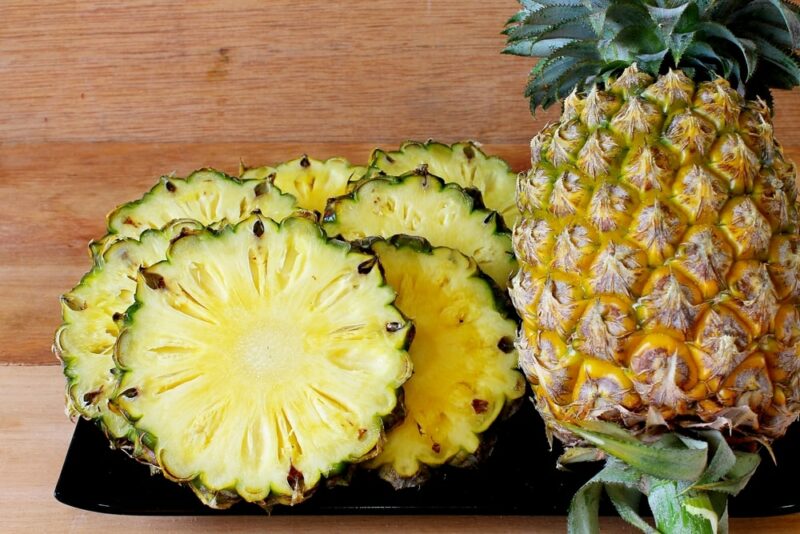Which Fruits Are Best For Juicing?
-
Nicole Wells
- Last updated:

There’s no such thing as a “bad” fruit for juicing. Fruits are loaded with essential vitamins, minerals, phytonutrients, and fibers that your body needs, which means any fruit you toss in your juicer will be good. But if you’re new to juicing, it’s a good idea to get used to the basics and understand how much juice you can expect to get from certain fruits, and which are most nutrient-dense. Which fruits are best for juicing? Apples, oranges, grapes, the list goes on. Below is our complete list of our favorite juicing fruits to help you decide where to start.
The 10 Best Fruits for Juicing:
1. Apples

Apples are one of the world’s favorite fruits to juice. They’re packed with fiber and potassium and are known for their anti-inflammatory and allergy-fighting properties. Be careful chugging too much apple juice, though. The sugar and simple carbohydrate content are both high. Use apple juice for cooking warm cider, brewing hard cider, or for a refreshing, cold drink. Check out our article on What Kinds of Apples are Best for Juicing for more information.
2. Oranges

Oranges are another popular juicing fruit famous for their high vitamin C content. They’re a natural immune system booster. Drink orange juice fresh for best results since some orange varieties have a high limonin content, which can turn your juice bitter. For the best juicing oranges, read our article on What Kinds of Oranges are Best for Juicing.
3. Grapes

Grape juice may be too sweet for some, but its power to lower LDL cholesterol (the bad kind), reduce the risk of blood clots, and decrease blood sugar levels makes it a top contender. Pop seedless grapes, such as red or green table grapes, right in the juicer. For bolder flavor, try Concord, Muscato, and cotton candy grapes. If your grapes have seeds, chuck them in a pot and cook them on medium heat until the grapes split and the juice releases, then press them through a sieve to remove the seeds. You can throw them in your juicing machine, too, but the seeds will get chopped, releasing a spicy flavor you may find unfavorable.
4. Pomegranates

Pomegranates are a superfood recommended by doctors and nutritionists alike. They’re loaded with antioxidants and are known to fight cancer, Alzheimer’s, arthritis, and heart disease. They’re sweet, they have a mild flavor, and their color is stunning. Pomegranates can be a pain to peel, so expect to spend some extra time on preparation.
5. Blueberries

Blueberries are another antioxidant powerhouse known for being chock-full of essential B vitamins. They can help with depression, protect against aging, and fight cancer. But blueberries are tiny, and you’ll need a large quantity of them to produce enough juice to fill a glass. If you’re not up to buying in surplus, you can always use blueberry juice as an adjunct to other flavors, like apple, cranberry, or other berry juices.
6. Pineapples

Piña colada, anyone? Tropical pineapple juice is high on the sweetness factor, but it makes a nice companion to creamy, mild coconut milk (and rum, if that’s your thing). Pineapples are high in vitamin C and manganese and are the only dietary source of bromelain, which is an anti-inflammatory enzyme that’s been shown to help heal muscle injuries.
7. Peaches

Buy peaches in late summer for the largest, juiciest fruit. Place them out at room temperature for a few days and let them soften; and their flavors will intensify and make a delicious cup of juice. Peaches are antioxidant-rich, great for the skin, and may help reduce allergies.
8. Cranberries

If you’ve eaten raw cranberries, you know they’re extremely tart. Cranberry juice should be watered down or mixed with other fruits for the best palatability. But it’s well worth the effort to find a tasty balance. When it comes to nutrition, these sour little berries are packing heat. They’re antioxidant-rich, they lower LDL cholesterol, and they can fight the bacteria that cause urinary tract infections (UTIs). Because of the cranberry’s potent properties, if you take any medications, consult a doctor before drinking cranberry juice regularly.
9. Lemons

Fresh-squeezed lemon juice isn’t drinkable by itself, but it’s great added to iced tea and fruit smoothies, poured over fish before cooking, and for flavoring desserts. For a treat on a hot summer day, try throwing some lemon juice and agave nectar in a blender with fresh strawberries for a stunning strawberry lemonade. You can make lemon juice in large batches and store it in the fridge or freeze it for later. It’s sure to come in handy.
10. Mangoes

Mango juice is delicious, rich, and sweet. It’s great mixed into lemonade, blended with strawberries, made into smoothies, or even as a sweetener in desserts. Be careful with mangoes, though. Peel them thoroughly before throwing them in the juicer, or you could be exposed to urushiol, a toxin in the skin also found in poison ivy. Once the skin is off, you’re in the clear. The antioxidants in mangoes are known to boost eye health and can fight asthma and diabetes.
Conclusion
We could give you an infinite list of fruit, but hopefully, this gives you a good idea of where to start. Do some research to get ideas for juice combinations, or experiment by grabbing all the fruit in your fridge and tossing them together. Whichever way you slice it, fruit juice is a good way to augment your health, strengthen your immune system, and live a longer life.
See Also:
- Did you know that juice pulp could be used as a fertilizer? (Read our post on alternative juice pulp uses here)
- How does the Nutri Ninja compare to the Nutribullet?
Featured Image Credit: Rawpixel
Contents



